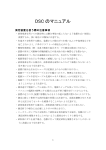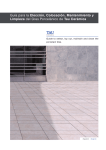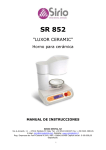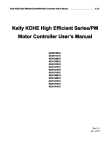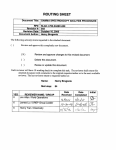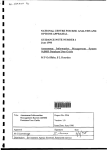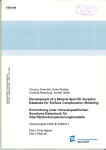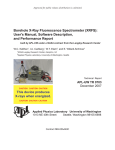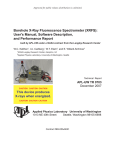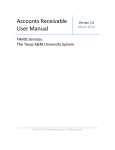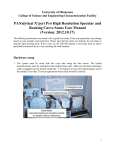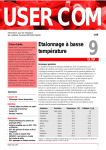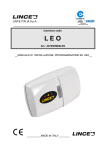Download Low level detection and quantification of carbonate species using
Transcript
Low level detection and quantification of carbonate species using thermogravimetric and differential thermal analysis Mineralogy, Petrology and Biostratigraphy Facility Internal Report IR/09/074 BRITISH GEOLOGICAL SURVEY MINERALOGY, PETROLOGY AND BIOSTRATIGRAPHY FACILITY INTERNAL REPORT IR/09/074 The National Grid and other Ordnance Survey data are used with the permission of the Controller of Her Majesty’s Stationery Office. Licence No: 100017897/ 2010. Low level detection and quantification of carbonate species using thermogravimetric and differential thermal analysis S J Kemp, D Wagner and I Mounteney Keywords calcite, dolomite, siderite, low level detection, thermogravimetry, differential thermal analysis. Front cover TGA/SDTA sample robot. Bibliographical reference KEMP, S.J., WAGNER, D. AND MOUNTENEY, I.. 2010. Low level detection and quantification of carbonate species using thermogravimetric and differential thermal analysis. British Geological Survey Internal Report, IR/09/074. 35pp. Copyright in materials derived from the British Geological Survey’s work is owned by the Natural Environment Research Council (NERC) and/or the authority that commissioned the work. You may not copy or adapt this publication without first obtaining permission. Contact the BGS Intellectual Property Rights Section, British Geological Survey, Keyworth, e-mail [email protected]. You may quote extracts of a reasonable length without prior permission, provided a full acknowledgement is given of the source of the extract. Maps and diagrams in this book use topography based on Ordnance Survey mapping. © NERC 2010. All rights reserved Keyworth, Nottingham British Geological Survey 2010 BRITISH GEOLOGICAL SURVEY The full range of our publications is available from BGS shops at Nottingham, Edinburgh, London and Cardiff (Welsh publications only) see contact details below or shop online at www.geologyshop.com The London Information Office also maintains a reference collection of BGS publications, including maps, for consultation. We publish an annual catalogue of our maps and other publications; this catalogue is available online or from any of the BGS shops. The British Geological Survey carries out the geological survey of Great Britain and Northern Ireland (the latter as an agency service for the government of Northern Ireland), and of the surrounding continental shelf, as well as basic research projects. It also undertakes programmes of technical aid in geology in developing countries. The British Geological Survey is a component body of the Natural Environment Research Council. British Geological Survey offices BGS Central Enquiries Desk Tel 0115 936 3143 email [email protected] Fax 0115 936 3276 Kingsley Dunham Centre, Keyworth, Nottingham NG12 5GG Tel 0115 936 3241 Fax 0115 936 3488 email [email protected] Murchison House, West Mains Road, Edinburgh EH9 3LA Tel 0131 667 1000 email [email protected] Fax 0131 668 2683 Natural History Museum, Cromwell Road, London SW7 5BD Tel 020 7589 4090 Fax 020 7584 8270 Tel 020 7942 5344/45 email [email protected] Columbus House, Greenmeadow Springs, Tongwynlais, Cardiff CF15 7NE Tel 029 2052 1962 Fax 029 2052 1963 Forde House, Park Five Business Centre, Harrier Way, Sowton EX2 7HU Tel 01392 445271 Fax 01392 445371 Maclean Building, Crowmarsh Gifford, Wallingford OX10 8BB Tel 01491 838800 Fax 01491 692345 Geological Survey of Northern Ireland, Colby House, Stranmillis Court, Belfast BT9 5BF Tel 028 9038 8462 Fax 028 9038 8461 www.bgs.ac.uk/gsni/ Parent Body Natural Environment Research Council, Polaris House, North Star Avenue, Swindon SN2 1EU Tel 01793 411500 Fax 01793 411501 www.nerc.ac.uk Website www.bgs.ac.uk Shop online at www.geologyshop.com HU U IR/09/074; Version 2 Last modified: 2010/03/25 09:11 Foreword 0B This report is the published product of a study by the British Geological Survey (BGS) and was produced under the Science Facilities’ Maintenance and Development of Capability (MaDCap) project. This report aims to provide a procedural manual for the newly acquired simultaneous thermogravimetric and differential thermal analysis system and details of initial testing to determine the low level detection and quantification of carbonate species. i IR/09/074; Version 2 Last modified: 2010/03/25 09:11 Contents 1B Foreword i Contents ii Summary iv 1 Introduction 1.1 Thermal analysis in the BGS 1.2 Mettler-Toledo SDTA851e System 1.3 Thermal analysis of carbonates 1 1 2 4 2 Materials and methods 2.1 Materials 2.2 Sample preparation 2.3 Characterisation of mineral standards 2.4 Thermal analysis 5 5 5 5 6 3 Results of thermal analyses 3.1 Mineral standards 3.2 Detection limits 9 9 9 4 Conclusions 14 5 Recommendations 14 References Appendix 1 15 BGS methodology 17 Appendix 2 Thermal analysis traces for the carbonate mineral standards and low detection limit mixture 24 FIGURES Figure 1. Mettler-Toledo SDTA851e system installation at BGS Keyworth. 2 Figure 2. Detail of sample robot loading a platinum crucible 3 Figure 3. Crucible sitting in its measurement position on the balance arm. Note that the sample changer has been removed and furnace retracted for clarity. The reactive gas supply capillary is arrowed. 3 ii IR/09/074; Version 2 Last modified: 2010/03/25 09:11 TABLES Table 1. Thermal methods 1 Table 2. Carbonate mineral decomposition in flowing CO2 atmosphere 4 Table 3. Summary of quantitative XRD analyses for the mineral standards 7 Table 4. Summary of XRFS geochemical analysis for the mineral standards 7 Table 5. Summary mixtures of quartz and carbonate 8 Table 6. Summary of thermal analyses of mineral standards 11 Table 7. Summary of thermal analysis of dolomite GSR-12 mixtures 12 Table 8. Summary of thermal analysis of calcite RC191/1 (Eire) mixtures 12 Table 9. Summary of thermal analysis of calcite RC194/1 (Canada) mixtures 13 Table 10. Summary of thermal analysis of siderite RC769/1 (Ivigtut, Greenland) mixtures 13 iii IR/09/074; Version 2 Last modified: 2010/03/25 09:11 Summary 2B This report describes a procedural manual for the newly acquired simultaneous thermogravimetric and differential thermal analysis system and details of initial testing to determine the low level detection and quantification of carbonate species. This work was carried out as part of the Science Facilities’ Maintenance and Development of Capability (MaDCap) project. The report firstly introduces the techniques of thermal analysis and BGS’s capabilities in this area. The report then details a series of experiments designed to determine the low level detection and quantification of carbonate species (calcite, dolomite and siderite). Results indicate that combined TGA-DTA analysis offers significantly lower levels of detection than other mineralogical techniques such as X-ray diffraction analysis. Measured carbonate species concentration levels as low as 200 ppm (dolomite and siderite) and 150 ppm (calcite) in synthetic mixtures are proved. Lower detection limits are possible but proving these is precluded by the difficulty of handling/weighing such small quantities. iv IR/09/074; Version 2 Last modified: 2010/03/25 09:11 1 Introduction 3B The International Confederation for Thermal Analysis and Calorimetry (ICTAC) defines ‘thermal analysis’ (TA) as a group of techniques in which a physical or chemical property of a sample is monitored against time or temperature while the temperature of the sample, in a specified atmosphere, is programmed (Hill, 1991). The more frequently used thermal analysis techniques and their uses are summarised in Table 1 (modified from Haines, 2002). Table 1. Thermal methods Technique Abbreviation Property Uses Thermogravimetry or (Thermogravimetric analysis) TG TGA Mass Decompositions, oxidations Differential thermal analysis DTA Temperature difference Phase changes, reactions Differential scanning calorimetry DSC Power difference of heat flow Heat capacity, phase changes, reactions Thermomechanical analysis TMA Deformations Mechanical changes Evolved gas analysis EGA Gases evolved or reacted Decompositions Thermoluminescence TL Light emitted Oxidation Thermomagnetometry TM Magnetic Magnetic changes, Curie points As with many areas of analytical science, it is unlikely that any single TA technique can provide all the information required to understand the behaviour of a sample. Instruments that provide two or more types of TA measurement at the same time (Simultaneous Thermal Analysis, STA) are therefore commonly employed (e.g. TG-DTA, TG-DSC, TG-DTA-EGA). TA techniques are widely employed across a range of disciplines including chemistry, materials science, foods and pharmaceuticals but are more rarely employed in geological/environmental laboratories. However, as demonstrated by the BGS laboratories (see next section), thermal methods frequently provide very useful complimentary data on the mineralogy and behaviour of geological materials. 1.1 THERMAL ANALYSIS IN THE BGS 9B The BGS Mineralogy & Petrology laboratories have a history of carrying out geoscience-related TA research since the 1960s. In fact, the facility is certainly the premier UK institution for TA in the geosciences with a prominent international reputation established by the frequent journal publications produced during the 1970s, 80s and 90s (e.g. Morgan, 1977; Milodowski & Morgan, 1980, 1984; Warne et al., 1985; Morgan et al., 1986; 1988ab; Milodowski et al., 1989; Inglethorpe & Morgan, 1993; Parsons et al., 1997). The equipment also proved invaluable for industrial mineral development projects (e.g. Harrison et al., 1998) and the characterisation of materials from UK NIREX’s low level, Sellafield and Dounreay investigations (e.g. Bloodworth et al., 1987; Kemp et al., 1991). 1 IR/09/074; Version 2 Last modified: 2010/03/25 09:11 However during the late 1990s and early 2000s, BGS TA activity declined due to a combination of a downturn in demand from both radwaste characterisation and industrial mineral projects, a loss of specialist staff and the restrictive nature of the 1970/80s-purchased equipment. In order to help re-stimulate TA activity in BGS, a successful proposal was made in April 2005 to purchase a state-of-the-art thermal analysis system which would offer simultaneous thermogravimetric and differential thermal analysis (TG-DTA) and efficiency gains through a sample changer facility. METTLER-TOLEDO SDTA851e SYSTEM 1.2 10B The purchased Mettler-Toledo SDTA851e system (Figure 1) provides the following: • High resolution (1 µg), internally calibrated thermobalance • Large temperature range (ambient to 1600˚C) furnace • High temperature accuracy (±0.5˚C), calibrated by pure metal melting points • Sample robot with 34 position sample changer allowing automatic processing and different crucible/program options (Figure 2). • Parallel guided balance ensures accurate, position-independent weight measurements (Figure 3). • Sample sizes up to 1000 mg in up to 900 µl crucibles • Data collection and interpretation using STARe software suite running on dedicated PC. • Programmable gas controller enabling two channel gas flow measurement, switching and monitoring. • Standalone re-circulating water cooling to provide constant measuring conditions and faster cooling between samples. • Ability to add coupled devices (e.g. FTIR spectrometer, mass spectrometer) Figure 1. Mettler-Toledo SDTA851e system installation at BGS Keyworth. 2 IR/09/074; Version 2 Last modified: 2010/03/25 09:11 Figure 2. Detail of sample robot loading a platinum crucible Figure 3. Crucible sitting in its measurement position on the balance arm. Note that the sample changer has been removed and furnace retracted for clarity. The reactive gas supply capillary is arrowed. Following installation, the system has provided useful data to a variety of projects (e.g. CO2 storage, limestone and industrial mineral assessment, contract analyses for external clients such as BPB Plc) but its potential has not been fully exploited due to a lack of R&D funding. 3 IR/09/074; Version 2 Last modified: 2010/03/25 09:11 THERMAL ANALYSIS OF CARBONATES 1.3 1B The presence of carbonate species (particularly calcite, dolomite, ankerite and siderite) in geological materials can routinely be determined and quantified by powder X-ray diffraction (XRD) analyses. However, the lower detection limits afforded by XRD for such species is of the order of 0.1wt%. Thermal analysis techniques, such as coupled TG-DTA have the ability to quantify lower levels of carbonate species and so complement XRD analysis, particularly where lower levels of detection are required. An important development in the detection and quantification of carbonate species was the use of ‘variable atmosphere thermal analysis’ (Warne, 1986). It was discovered that running carbonate species TA experiments in flowing CO2, rather than N2 or air, provided improved individual peak and reaction definition. By adopting the same purge gas as that released during sample decomposition, the carbonate species has to overcome the increased CO2 partial pressure before decarboxylation. This results in increased decomposition temperatures and faster, more vigorous reactions over a smaller temperature range. A summary of common carbonate mineral decomposition characteristics is shown in Table 2. Table 2. Carbonate mineral decomposition in flowing CO2 atmosphere Reaction Carbonate species Calcite Dolomite Siderite Temperature range (˚C) Weight loss (%) Step Equation Total CaCO3 → CaO + CO2 900 - 1000 43.97 1. CaMg (CO3 ) 2 → CaCO3 + MgO + CO2 550 - 765 23.86 2. CaCO3 → CaO + CO2 900 - 1000 43.97 Total CaMg (CO3 ) 2 → CaO + MgO + 2CO2 550 – 1000 47.77 Total* FeCO3 → FeO + CO2 450 - 550 37.99 *the siderite decomposition mechanism is strongly linked to oxygen fugacity. The data shown relates to low oxygen fugacity as would be expected to be produced by a flowing CO2 atmosphere. The rapid, low level detection and quantification of carbonate species afforded by TA techniques is capable of providing useful data to a wide range of BGS projects but is particularly important in studies related to CO2 storage, from analogue and demonstration sites to supporting laboratory studies. Reactions between CO2-rich porewaters and carbonate cements in reservoirs and/or cap rocks are relatively fast. Therefore the detection of low-levels of carbonate minerals is fundamental to understanding long-term storage processes. This report therefore presents the results of a small study carried out during 2008/09 under the Maintenance and Development of Capability (MaDCap) project which aimed to: • familiarise BGS staff with the newly-purchased thermal analysis system • produce a user manual • determine the lower limits of detection for carbonate species by TG-DTA • advertise the abilities of the new system to BGS project leaders 4 IR/09/074; Version 2 Last modified: 2010/03/25 09:11 2 Materials and methods 4B 2.1 MATERIALS 12B The following ‘pure’ mineral standards were sourced from the BGS reference collection: • RC769/1 Siderite (Ivigtut, Greenland) • RC193/1 Dolomite (Larangwe, Blantyre District, Malawi) • RC194/1 Calcite (Canada) • RC191/1 Calcite (Eire) together with: 2.2 • GSR-12 Dolomite (mineral standard from BGS XRFS laboratories) • Quartz (BGS XRD lab, locality unknown) SAMPLE PREPARATION 13B A representative sub-sample of each sample was removed and then hand-crushed in a pestle and mortar. The crushed material was then ball-milled to <0.125 mm. 2.3 CHARACTERISATION OF MINERAL STANDARDS 14B To identify whether the selected materials were suitable for this study, each was firstly mineralogically examined using XRD analysis followed by major element geochemical analysis by X-ray fluorescence spectroscopy (XRFS). 2.3.1 X-ray diffraction analysis 18B In order to provide a finer and uniform particle-size for whole-rock XRD analysis, a c.3 g portion of the ball-milled material was wet-micronised under acetone for 10 minutes, dried, disaggregated and back-loaded into standard stainless steel sample holders for analysis. XRD analysis was carried out using a PANalytical X’Pert Pro series diffractometer equipped with a cobalt-target tube, X’Celerator detector and operated at 45kV and 40mA. The samples were scanned from 4.5-85°2θ at 2.76°2θ/minute. Diffraction data were initially analysed using PANalytical X’Pert HighScore Plus Version 2.2a software coupled to the latest version of the International Centre for Diffraction Data (ICDD) database. Following identification of the mineral species present in the samples, mineral quantification was achieved using the Rietveld refinement technique (e.g. Snyder & Bish, 1989) using PANalytical HighScore Plus software. This method avoids the need to produce synthetic mixtures and involves the least squares fitting of measured to calculated XRD profiles using a crystal structure databank. Errors for the quoted mineral concentrations are typically ±2.5% for concentrations >60 wt%, ±5% for concentrations between 60 and 30 wt%, ±10% for concentrations between 30 and 10 wt%, ±20% for concentrations between 10 and 3 wt% and ±40% for concentrations <3 wt% (Hillier et al., 2001). Where a phase was detected but its concentration was indicated to be below 0.5%, it is assigned a value of <0.5%, since the error associated with quantification at such low levels becomes too large. 5 IR/09/074; Version 2 Last modified: 2010/03/25 09:11 X-ray fluorescence spectroscopy 2.3.2 19B For geochemical analysis, the ground samples were dried at 105°C before fusion and determination of loss on ignition (LOI). To determine the LOI, samples were heated in a muffle furnace for 1 hour at 1050˚C. Approximately 1 g of sample was weighed accurately into a porcelain crucible. The crucible was weighed before and after heating and the two weights compared. The resulting relative loss in sample weight was reported as the LOI. Fused beads were prepared by fusing 0.9000 g sample plus 9.000 g flux (66/34 Li2B4O7 and LiBO2) at 1200°C. All samples were analysed using these conditions for internal consistency within the batch. After fusion the melt was cast into a 40 mm fused glass bead, which was then analysed by XRFS. The XRFS spectrometer used was a Philips MagiX Pro fitted with a 60 kV generator and 4 kW rhodium (Super Sharp) end–window X-ray tube controlled via PC running PANalytical SuperQ XRF application package. The PANalytical calibration algorithm is used to fit calibration curves and inter-element effects are corrected by theoretical alpha coefficients, calculated by the PANalytical method. All spectral backgrounds and peaks are corrected for instrument drift using two external ratio monitors. Results 2.3.3 20B The results of initial characterisation of the project materials by XRD and XRFS are summarised in Tables 3 and 4. XRD analysis of sample ‘RC193/1 Dolomite (Larangwe, Blantyre District, Malawi)’ showed that although dolomite formed the major component of this material, significant quantities of quartz, calcite and undifferentiated mica species were also identified. No further analyses were therefore carried out on this sample and it was removed from the investigation. XRD and XRFS analyses indicated that the remaining samples were of sufficient purity for their inclusion in the study. 2.4 THERMAL ANALYSIS 15B Prior to commencing analyses, the TG-DTA system was calibrated using the specified Indium/Aluminium (In/Al) melting test. As the measured values were outside the specified limits, a total adjustment was performed and the In/Al check repeated to check compliance. Zero runs were then completed for empty 150 µl platinum crucibles from 30 to 1100˚C in a gas flow of 80 ml/minute CO2 at a heating rate of 10˚C/minute. However, when employing N2 as the purge gas and CO2 gas as the reactive gas, the TG curve showed an unaccountable weight loss at approximately 100ºC. Having excluded all the possible causes for this (new platinum crucibles, exchange of CO2 gas cylinder and replacement gas lines in the laboratory), advice was sought from the manufacturer. Mettler-Toledo suggested that baseline runs should be performed without any crucibles under following conditions: • N2 protective gas and no reactive gas • N2 protective gas and N2 reactive gas • N2 protective gas and CO2 reactive gas • CO2 protective and reactive gas The results of these runs showed that the mysterious weight loss at c.100 ºC was only produced with a combination of N2 as the protective gas and CO2 as reactive gas. Mettler-Toledo could not provide an adequate explanation for this phenomenon but believed it to be the result of gas mixing and possible back-pressure(s). Despite the possible corrosive effect of CO2 on the 6 IR/09/074; Version 2 Last modified: 2010/03/25 09:11 Table 3. Summary of quantitative XRD analyses for the mineral standards calcite dolomite siderite quartz hematite Mineralogy (%) GSR-12 Dolomite MPLM701 nd 99.5 nd 0.5 nd RC191/1 Calcite (Eire) MPLM702 100 nd nd nd nd RC194/1 Calcite (Canada) MPLM703 100 nd nd nd nd RC769/1 Siderite (Greenland) MPLM704 nd nd 97.1 0.8 2.1 Quartz MPLM705 nd nd nd 100 nd Incoming sample name BGS Code KEY nd = not detected U Table 4. Summary of XRFS geochemical analysis for the mineral standards Incoming sample BGS MPL name code SiO2 TiO2 Al2O3 Fe2O3t Mn3O4 MgO CaO Na2O K2O P2O5 SO3 Cr2O3 SrO ZrO2 BaO NiO CuO ZnO PbO LOI Total n/a n/a n/a n/a n/a n/a n/a n/a % GSR-12 Dolomite MPLM701 0.62 0.02 0.10 RC191/1 Calcite MPLM702 0.03 <0.01 <0.01 <0.01 0.02 0.24 56.12 <0.05 <0.01 <0.01 <0.1 <0.01 0.03 <0.02 <0.02 <0.01 <0.01 <0.01 <0.01 43.32 99.76 RC194/1 Calcite MPLM703 0.02 <0.01 <0.01 0.16 0.02 0.22 56.62 <0.05 <0.01 <0.01 <0.1 <0.01 0.06 <0.02 <0.02 <0.01 <0.01 <0.01 <0.01 43.93 101.03 RC769/1 Siderite MPLM704 0.02 <0.02 <0.02 96.88 4.72 0.19 <0.02 <0.02 <0.03 <0.03 <0.02 <0.02 Quartz MPLM705 99.70 <0.01 0.02 0.20 0.01 21.76 30.02 0.03 0.04 <0.01 <0.1 0.02 <0.06 <0.02 <0.02 <0.2 0.14 <0.01 <0.05 <0.01 <0.05 <0.01 <0.01 <0.1 KEY n/a = not available U 7 n/a n/a 0.02 <0.02 26.90 101.85 <0.01 <0.01 <0.02 <0.02 <0.01 <0.01 <0.01 <0.01 0.16 100.02 IR/09/074; Version 2 Last modified: 2010/03/25 09:11 delicate microthermobalance, Mettler’s suggestion to run measurements with CO2 as both the protective and reactive gas was used throughout this study. [Subsequent discussions with other users of the same instrument at Saint Gobain Gypsum, East Leake revealed that they had encountered similar problems when running with an N2 protective gas and CO2 reactive gas. The cause is still unknown]. For thermal analysis c.50 - 65 mg portions of each powdered sample were heated in 150 µl platinum crucibles from 30 to 1100˚C in a gas flow of 80 ml/minute CO2 at a heating rate of 10˚C/minute. In order to establish the lower detection limit of the different carbonate species, a series of mixtures of quartz with each carbonate species was prepared for TG-DTA analysis (Table 5). A total of 50 mg of each standard mixture was then accurately weighted into 150 µl platinum crucibles using a 5 decimal place Sartorius R200D balance. Table 5. Summary mixtures of quartz and carbonate quartz Mixture no. carbonate % mg % mg 1 98.000 49.000 2.000 1.000 2 99.000 49.500 1.000 0.500 3 99.500 49.750 0.500 0.250 4 99.800 49.900 0.200 0.100 5 99.900 49.950 0.100 0.050 6 99.950 49.975 0.050 0.025 7 99.980 49.990 0.020 0.010 The presence and quantification of the different carbonate species was determined by comparison with empirically-derived standard weight losses and temperatures (Table 2). However, in the case of the siderite standard RC769/1, TGA produced a weight loss of 27.70% (not 37.99% as shown by the equation in Table 2). Despite intensive research, no single, stoichiometric equation could be derived to explain this weight loss and it is therefore presumed to represent either incomplete reaction or the combination of two separate reactions. The standard siderite weight loss of 27.70% was used throughout this study. 8 IR/09/074; Version 2 Last modified: 2010/03/25 09:11 3 Results of thermal analyses 5B 3.1 MINERAL STANDARDS 16B The results of thermal analysis of the selected carbonate mineral standards are summarised in Table 6 and the labelled thermal analysis traces in Appendix 2. The dolomite-bearing sample GSR-12 shows two major weight losses between c.730 and c.770ºC and between c.930 and c.960ºC which can both be ascribed to dolomite decomposition. Assuming that the dolomite has a close to end-member (non-ferroan) composition (CaMg(CO3)2), the dolomite concentration was calculated by comparison with the weight loss of a standard non-ferroan dolomite (47.73%, Table 2). The slight difference in weight loss between the two endothermic reactions suggests that the Mg:Ca ratio is not exactly 1:1 possibly caused by the substitution of Fe2+, Mn2+, Zn2+ or Ni2+ in the dolomite structure. A weak third endothermic effect between c.600 and c.650 ºC presents further evidence of some Fe2+ in the dolomite structure which is also confirmed by geochemistry data (Table 4). The two calcite-bearing samples (RC191/1 and 194/1) show similar thermogravimetric profiles with a major, c.44% weight loss between c.950-987 ˚C. The weight loss suggests close-to-pure calcite contents of 99.73% (RC191/1) and 99.93% (RC194/1) respectively. The siderite-bearing sample (RC769/1) produced a lower temperature weight loss between c.474 and 537 ˚C of c.27.7%, equivalent to c.97.4% siderite. 3.2 DETECTION LIMITS 17B Seven mixtures of each carbonate standard were run in 150 µl platinum crucibles from 30 to 1100˚C in a gas flow of 80 ml/minute CO2 at a heating rate of 10˚C/minute. The results are summarised in Tables 7 to 10. As shown by the tabulated data, TA confirms the presence of carbonate in the mineral mixtures and quantification suggests concentrations very close to those that were planned. Variation from the planned concentrations (generally <5%) is almost certainly due to errors inherent in the weighing and preparation of the mixtures. Larger errors were encountered for the siderite mixtures which may be due to the greater difficulty in separating and accurately weighing the iron-rich siderite particles which exhibit a mild magnetism and tend to form aggregates. The larger siderite errors may also possibly relate to the incomplete or dual reactions suggested in section 2.4. In all cases the lowest carbonate concentration (0.020 %, 200 ppm) was detected and quantified. However, the detection of lower carbonate concentrations was precluded by the inability to accurately weigh samples of <0.01 mg using the 5 decimal place Sartorius R200D balance due to static effects between the mineral grains. In order to determine the lowest detection limit for calcite in a composite sample using the TGDTA technique, additional experiments were carried out using a Sartorius ME5 6-decimal figure balance. Sample MPLM702 (Calcite RC191/1) was chosen as it showed the highest purity. The smallest, transferable quantities of calcite were weighed into a platinum crucible before adding between c.120 and c.160 mg quartz to produce calcite concentrations of c.0.01%, 100 ppm. The sample mixtures were then analysed as those previously. Sample details and results are shown in Table 9 (lower entries). An example TG curve for a low detection limit mixture is shown in Appendix 2. 9 IR/09/074; Version 2 Last modified: 2010/03/25 09:11 Using such a technique, TG-DTA analyses successfully recorded a weight loss of 6.7291e-3 % which equates to an initial calcite weight of 0.015 % (150 ppm). Considering the size of the weight loss measured (Appendix 2), it would appear that the technique is capable of detecting lower calcite concentrations of perhaps 100 mg. However, proving this to be the case is precluded by handling/weighing difficulties. 10 IR/09/074; Version 2 Last modified: 2010/03/25 09:11 Table 6. Summary of thermal analyses of mineral standards Weight loss Incoming sample name GSR-12 Dolomite BGS Code MPLM701 no. temperature range (˚C) % attributed to 1 c.611 – c.642 2.1278 dolomite decomposition 1 2 c.744 – c.769 21.1893 dolomite decomposition 2 3 c.933 – c.962 23.6167 dolomite decomposition 3 Equivalent calcite content (%) Equivalent siderite content (%) 98.96 RC191/1 Calcite MPLM702 1 c.950 – c.987 43.8504 calcite decomposition 99.73 RC194/1 Calcite MPLM703 1 c.949 – c.987 43.9397 calcite decomposition 99.93 RC769/1 Siderite MPLM704 1 c.474 – c.537 27.7040 siderite decomposition 11 Equivalent dolomite content (%) 97.24 IR/09/074; Version 2 Last modified: 2010/03/25 09:11 Table 7. Summary of thermal analysis of dolomite GSR-12 mixtures Mixture no. 1 2 3 4 5 6 7 quartz (%) 98.000 99.000 99.500 99.800 99.900 99.950 99.980 dolomite (%) 2.000 1.000 Weight loss no. temperature range (˚C) % 1 c.601 – c.628 2 c.738 – c.758 0.4136 dolomite decomposition 2 3 c.937 – c.945 0.5042 dolomite decomposition 3 1 c.641 – c.657 2 c.733 – c.753 0.1424 dolomite decomposition 2 3 c.937 – c.944 0.1820 dolomite decomposition 3 1 c.737 – c.759 2 c.934 – c.946 1 c.738 – c.747 45.6772e-3 dolomite decomposition 1 2 c.937 – c.940 61.3174e-3 dolomite decomposition 2 1 c.732 – c.743 15.8691e-3 dolomite decomposition 1 2 c.935 – c.942 29.0146e-3 dolomite decomposition 2 1 c.735 – c.750 6.3248e-3 dolomite decomposition 1 2 c.939 – c.941 17.1661e-3 dolomite decomposition 2 1 c.730 – c.750 1.4801e-3 dolomite decomposition 1 2 c.937 – c.948 9.2926e-3 dolomite decomposition 2 Equivalent dolomite content (%) attributed to 47.7829e-3 dolomite decomposition 1 2.02 12.3291e-3 dolomite decomposition 1 0.71 94.2459e-3 dolomite decomposition 1 0.500 0.51 0.1477 dolomite decomposition 2 0.22 0.200 0.09 0.100 0.05 0.050 0.02 0.020 Table 8. Summary of thermal analysis of calcite RC191/1 (Eire) mixtures Weight loss Equivalent calcite content (%) Mixture no. quartz (%) calcite (%) no. temperature range (˚C) % 1 98.000 2.00 1 c.954 – c.965 0.9216 calcite decomposition 2.10 2 99.000 1.00 1 c.952 – c.964 0.4299 calcite decomposition 0.98 3 99.500 0.500 1 c.950 – c.962 0.2262 calcite decomposition 0.51 4 99.800 0.200 1 c.956 – c.961 77.0416e-3 calcite decomposition 0.18 5 99.900 0.100 1 c.948 – c.959 61.8439e-3 calcite decomposition 0.14 6 99.950 0.050 1 c.947 – c.959 19.4092e-3 calcite decomposition 0.04 7 99.980 0.020 1 c.950 – c.955 9.9869e-3 calcite decomposition 0.02 12 attributed to IR/09/074; Version 2 Last modified: 2010/03/25 09:11 Table 9. Summary of thermal analysis of calcite RC194/1 (Canada) mixtures Weight loss Equivalent calcite content (%) Mixture no. quartz (%) calcite (%) no. temperature range (˚C) 1 98.000 2.000 1 c.948 – c.965 0.9010 calcite decomposition 2.05 2 99.000 1.000 1 c.949 – c.965 0.4809 calcite decomposition 1.09 3 99.500 0.500 1 c.947 – c.961 0.2140 calcite decomposition 0.49 4 99.800 0.200 1 c.949 – c.961 88.1119e-3 calcite decomposition 0.20 5 99.900 0.100 1 c.948 – c.964 55.9616e-3 calcite decomposition 0.13 6 99.950 0.050 1 c.949 – c.963 32.0740e-3 calcite decomposition 0.07 7 99.980 0.020 1 c.945 – c.954 12.6495e-3 calcite decomposition 0.03 8 99.0000 0.0090 1 c.940 – c.970 6.8588e-3 calcite decomposition 0.016 9 99.0000 0.0160 1 c.940 – c.970 8.9111e-3 calcite decomposition 0.020 10 99.5000 0.0090 1 c.940 – c.970 6.7291e-3 calcite decomposition 0.015 11 99.8000 0.0120 1 c.940 – c.970 7.2632e-3 calcite decomposition 0.017 12 99.9000 0.0120 1 c.940 – c.970 6.7902e-3 calcite decomposition 0.015 % attributed to Table 10. Summary of thermal analysis of siderite RC769/1 (Ivigtut, Greenland) mixtures Weight loss Equivalent siderite content (%) Mixture no. quartz (%) siderite (%) no. temperature range (˚C) % 1 98.000 2.000 1 c.467 – c.503 0.5143 siderite decomposition 1.86 2 99.000 1.000 1 c.455 – c.493 0.2932 siderite decomposition 1.01 3 99.500 0.500 1 c.462 – c.500 0.1610 siderite decomposition 0.58 4 99.800 0.200 1 c.482 – c.501 58.5861e-3 siderite decomposition 0.21 5 99.900 0.100 1 c.473 – c.499 42.1219e-3 siderite decomposition 0.15 6 99.950 0.050 1 c.496 – c.508 9.6436e-3 siderite decomposition 0.03 7 99.980 0.020 1 c.495 – c.510 419.6167e-6 siderite decomposition 0.01 13 attributed to IR/09/074; Version 2 Last modified: 2010/03/25 09:11 4 Conclusions 6B • The Mettler-Toledo SDTA851e thermal analysis system has been successfully installed and a BGS user manual has been written and working methodologies implemented. • For the detection and quantification of low levels of carbonate species, combined TGADTA analysis offers significantly lower levels of detection than other mineralogical techniques such as X-ray diffraction analysis. • TGA-DTA studies have measured concentration levels as low as 200 ppm (dolomite, siderite) and 150 ppm (calcite) in synthetic mixtures. Even lower detection limits are possible using this method but proving these is precluded by the difficulty of handling/weighing such small quantities. 5 Recommendations 7B • Users are advised to follow the protocols outlined in this report and the analysis programs setup. This report should be quoted when reporting data produced by the thermal analysis system. 14 IR/09/074; Version 2 Last modified: 2010/03/25 09:11 References 8B British Geological Survey holds most of the references listed below, and copies may be obtained via the library service subject to copyright legislation (contact [email protected] for details). The library catalogue is available at: http://geolib.bgs.ac.uk. HU UH BLOODWORTH, A.J., KEMP, S.J., INGLETHORPE, S.D.J. and MORGAN, D.J. 1987. Mineralogy and lithochemistry of strata beneath proposed low-level radioactive waste site at Bradwell, Essex; Report to Sir William Halcrow and Partners, Site Investigation Consultants. British Geological Survey Technical Report 87/13/C. HAINES, P.J. 2002. Principles of Thermal Analysis and Calorimetry. In: HAINES P.J, editor. The Royal Society of Chemistry. 320p. HARRISON, D.J., INGLETHORPE, S.D.J., Mitchell, C.J., KEMP, S.J., CHAODUMRONG, P. and CHARUSRIBANDHU, M. 1998. Procedures for the rapid assessment of limestone resources. British Geological Survey Technical Report WC/98/1. HILL, J.O. 1991. For Better Thermal Analysis and Calorimetry. 3rd Ed., International Confederation for Thermal Analysis (ICTA), Newcastle, Australia. HILLIER, S., SUZUKI, K. AND COTTER-HOWELLS, J. 2001. Quantitative determination of Cerussite (lead carbonate) by X-ray powder diffraction and inferences for lead speciation and transport in stream sediments from a former lead mining area of Scotland. Applied Geochemistry, 16, 597-608. INGLETHORPE S.D.J. AND MORGAN D.J. 1993. Detection of ammonium in geological materials by evolved gas analysis. Journal of Thermal Analysis, 40, 29-40. KEMP, S.J., INGLETHORPE, S.D.J. and WASPE, T.J. 1991. Bulk mineralogical data for samples from the Devonian of Dounreay BH1. UK Nirex Core Characterisation Series Report CC91D/030/IF-A-C. MILODOWSKI A.E. AND MORGAN D.J. 1980. Identification and estimation of carbonate minerals at low-levels by evolved CO2 analysis. Nature, 286, 248-249. MILODOWSKI A.E. AND MORGAN D.J. 1984. Thermal-reactions of Leadhillite Pb4SO4(CO3)2(OH)2. Clay Minerals, 19(5), 825-841. MILODOWSKI A.E., MORGAN D.J., WARNE S.ST.J. 1989. Thermal-analysis studies of the dolomite-ferroan dolomite-ankerite series .2. Decomposition mechanism in flowing CO2 atmosphere. Thermochimica Acta, 152(2), 279-297. MORGAN D.J., 1977. Simultaneous DTA-EGA of minerals and natural mineral mixtures. Journal of Thermal Analysis, 12(2), 245-263. MORGAN D.J., WARNE S.ST.J., WARRINGTON, S.B. AND NANCARROW, P.H.A. 1986. Thermaldecomposition reactions of caledonite and their products. Mineralogical Magazine, 50, 357, 521-526. MORGAN D.J., WARRINGTON, S.B AND WARNE S.ST.J. 1988a. Earth sciences applications of evolved gas-analysis - a review. Thermochimica Acta, 135, 207-212. MORGAN D.J., MILODOWSKI A.E., WARNE S.ST.J., WARRINGTON, S.B. 1988b. Atmosphere dependence of the thermal-decomposition of manganite, gamma-MnO.OH. Thermochimica Acta, 135, 273-277. 15 IR/09/074; Version 2 Last modified: 2010/03/25 09:11 PARSONS A.J., INGLETHORPE S.D.J., MORGAN D.J., AND DUNHAM, A.C. 1997. Evolved gas analysis (EGA) of brick clays, Journal of Thermal Analysis 48(1), 49-62. H H SNYDER, R.L. AND BISH, D.L. 1989. Quantitative analysis. In: Bish, D.L., Post, J.E. (Eds), Modern Powder Diffraction, Reviews in Mineralogy, Volume 20, Mineralogical Society of America, USA, pp. 101-144 (Chapter 5). WARNE S.ST.J., BLOODWORTH, A.J. AND MORGAN D.J. 1985. Thermomagnetometry and evolved gas-analysis in the identification of organic and pyritic sulfur in coal and oil-shale. Thermochimica Acta, 93, 745-748. WARNE S.ST.J. 1986. Applications of variable atmosphere DTA (in CO2) to improved detection and content evaluation of anhydrous carbonates in mixtures. Thermochimica Acta, 109, 243252. 16 IR/09/074; Version 2 Last modified: 2010/03/25 09:11 Appendix 1 BGS methodology OPERATING INSTRUCTIONS FOR THE METTLER-TOLEDO SDTA851e THERMAL ANALYSIS SYSTEM (ROOM P029) 17 IR/09/074; Version 2 Last modified: 2010/03/25 09:11 1 RESTING CONDITIONS The TGA/SDTA851e should be permanently left on and the balance constantly purged with N2 as a protective gas (c. 10cm3/min on flowmeter). [CO2 may also be used as a protective gas for a short time period where CO2 is to be used as reactive gas, to avoid an unexpected low temperature weight gain]. Check the recirculating cooling agent (22ºC) on a regular basis for water level and contamination. If the water level has dropped, top-up as necessary. If the coolant shows any cloudiness, drain the fluid and replace using the correct dilution ratio. Also check that the water flow is maintained using the red flow-wheel indicator. 2 PREPARATION (DAY BEFORE ANALYSIS) 2.1 Ensure TGA/SDTA851e is switched on. [The mains switch (red) is located towards the top of the rear panel of the module.] 2.2 Switch on the PC and log on to the AD domain. 2.3 Double-click on the STARe software program icon on the desktop. Note: If an error message appears, refer to Appendix M1 for guidance. 2.4 Enter username (METTLER) and password () 2.5 Check that adequate supplies of N2 and/or CO2 gases are available in the cylinder store (DP407 in P-U block quadrangle) and open relevant regulators. 2.6 In P029, gradually turn on the gas supply at the relevant gas tap (CO2 or N2) making sure that the gas pressure indicated on the inline pressure gauge does not exceed 0.8 bar. 2.7 On the TGA/SDTA851e control panel, depress the ‘Rotate’ button until ‘Gas1 and ‘Gas2’ appear on LCD display. Then, also on the TGA/SDTA851e control panel, depress the gas button (2 gas cylinder symbols, labelled ‘1’ and ‘2’) to indicate the reactive gas flow rate. Note that by default, ‘Gas 1’ indicates N2 and ‘Gas2’ indicates CO2. 2.8 On the gas flow control unit (TS0800GC1) beside the TGA/SDTA851e, turn the knob 1 (N2) or 2 (CO2) respectively to adjust the reactive gas flow to 80ml/min (shown on the TGA/SDTA851e control panel). Make sure that the protective gas (N2or CO2) flows at ~10cm3/min on the flowmeter, adjusting using the knob on the flowmeter itself. 2.9 Leave the gas(es) switched on overnight to settle and purge the TGA/SDTA851e. 18 IR/09/074; Version 2 Last modified: 2010/03/25 09:11 3 CALIBRATION AND ADJUSTMENT 3.1 Before each batch of samples, perform a calibration check using the supplied In/Al metal standards. 3.2 From within the STARe software, click on the ‘Routine editor’. 3.3 From the ‘Method’ drop down menu, select ‘Select’ - ‘Check TGA851 In/Al’. 3.4 Place an alumina crucible containing the prepared In/Al mixture in position 34 on the carousel. Note: The In/Al standard can be re-used for future calibrations. 3.5 Fill in the weight of pre-prepared In/Al (taking details from the sheet pinned to notice board in P029), add the sample name ‘In/Al check’ and sample position ‘134’. 3.6 Click ‘Send Experiment’. 3.7 To evaluate whether the In/Al check is within specification, open the Evaluation Window by minimising the Module Control Window. 3.8 From the ‘Functions’ drop down menu, select ‘Evaluation Window’. 3.9 From the ‘File’ drop down menu, select ‘Open’ and then ‘Evaluation’. Select the relevant In/Al check and follow the instructions that appear in the window. 3.10 The In/Al check is evaluated automatically. If the values are within specification, the following text appears: ‘The Module is within specifications!’. If the values are not within specification, the following text appears: ‘Please adjust the TGA/SDTA851e!’. 3.11 If the results of the check are not within specification, repeat the experiment with new standard materials. If the results are still not within specification, carry out a total adjustment (see Appendix M2). 19 IR/09/074; Version 2 Last modified: 2010/03/25 09:11 4 SAMPLE ANALYSIS 4.1 From within the STARe software, click on the ‘Routine editor’. 4.2 From the ‘Method’ drop down menu, select ‘Select’ and choose the relevant method from the options displayed in the window. 4.3 On the Sartorius 5-figure balance, weigh a clean crucible of correct material for analysis (platinum, aluminium, ceramic etc), zero the balance and weigh sample material (usually c.50mg) into the crucible. Record the sample weight. 4.4 In the software window, fill in the sample name, sample weight and sample position in the carousel. [The first sample position on the sample carousel is 101.] 4.5 Note: When carrying out experiments involving temperatures above 1100ºC and platinum crucibles, make sure that a sapphire disk is placed on the sample holder arm before analysis! 4.6 Click ‘Send Experiment’. 5 EVALUATION 5.1 From the main STARe software window, click ‘Functions’ drop down menu and select the ‘Evaluation window’. In the new window from the ‘File’ drop down menu, select ‘Open curve’. Select the required sample curve and click ‘Open’. 5.2 To additionally display the DTG curve, select ‘Math’ and ‘1st derivative’. 5.3 To additionally display the DTA curve, select ‘TA’ and ‘SDTA’. 5.4 To calculate weight losses, click on the original curve (always remember to click on the curve you want to work on) and draw a window over the area of the weight loss. Select ‘TA’ and ‘Step Horiz.’ or ‘Step Tang.’ Values for weight loss in % and g will appear adjacent to the curve. 5.5 When calculations/graphical manipulation complete, click the ‘File‘ drop down menu and select ‘Save evaluation’. Fill in appropriate file name, using MPL code. 20 IR/09/074; Version 2 5.6 Last modified: 2010/03/25 09:11 To export an evaluation for reporting purposes, click the ‘File‘ drop down menu and select ‘Import/Export’ and ‘Export other format’ (e.g. *.emf, *.tif, *.txt). 6 TERMINATING THE STARe SOFTWARE AND SHUT-DOWN 6.1 In Evaluation window, click the ‘File‘ drop down menu and select ‘Exit’. 6.2 From the main STARe software window, click ‘System’ drop down menu and select the ‘Exit’. Shut down PC as usual. 6.3 Turn back gas flow of Nitrogen until c.10cm3/min is shown on the flow-meter. In case of CO2 usage, turn off gas at the gas tap in P029 and via the regulator and cylinder in DP407. 21 IR/09/074; Version 2 Last modified: 2010/03/25 09:11 APPENDIX M1. Error message while logging into the STARe software. This procedure is necessary if an error message is received when attempting to start the STARe software system. This procedure restarts the INGRES database. 1.1 Log off AD domain. 1.2 Log in as ‘KWP19767 (this computer)’. 1.3 Enter username ‘INGRES’ and password ‘weiqing1’. 1.4 From the Start Menu, select ‘Control Panel’. 1.5 Select ‘Administrative Tools’ and then ‘Services’. 1.6 Select ’Ingres intelligent database [II]’ from the list. 1.7 Within the new window, select the ’log on’ tab. 1.8 Fill in the log in name ’.\ingres’ and password ‘weiqing1’ and click the ’Apply’ button. 1.10 A window ‘The account .\ingres has been granted the Log On As A Service right’ will appear. Click ‘OK’ button. 1.11 On the ‘General’ tab, click the ‘Start’ button. A window will appear advising that ‘Windows is attempting to start the Ingres Intelligent Database II’. Click ‘OK’. 1.12 Close all windows and log off. 1.13 log on AD domain as per usual. 22 IR/09/074; Version 2 Last modified: 2010/03/25 09:11 APPENDIX M2 Total adjustment. This procedure is necessary if the results of the In/Al calibration check are outside specification. 1.1 From within the STARe software, click on the ‘Routine editor’ and select ‘Total adjustment’. 1.2 Prepare the sample for the experiment by following the instructions in text box. An alumina crucible with In/Al total is already placed on the carousel on position 131 which can be re-used. The weight for this pre-prepared standard is shown on the sheet on the notice board in P029. 1.3 Fill in sample name ‘In/Al total’, the sample weight (from details on the notice board) and sample position ‘131’. 1.4 Click ‘Send Experiment’. 1.5 After completion of the experiment, an information box will appear with the new calibration values. Click ‘OK’ button to accept these new values. 1.6 Perform another In/Al check (Section 3) to see if the values are now within limits. 23 IR/09/074; Version 2 Last modified: 2010/03/25 09:11 Appendix 2 Thermal analysis traces for the carbonate mineral standards and low detection limit mixture [TG traces are shown in red, DTG traces are shown in black except for low detection limit sample where only the TG trace isshown] GSR-12 Dolomite, MPLM701 % g Onset 610.64 °C Endset 642.40 °C Step -2.1278 % -1.4009 mg &!MPLM701 MPLM701, 65.8400 mg 100 95 90 Onset 744.17 °C Endset 769.00 °C Step -21.1893 % -13.9510 mg 85 80 0.005 1/°C 75 Onset Endset 933.66 °C 962.36 °C Step -23.6167 % -15.5492 mg 70 65 60 55 50 50 100 150 200 250 300 350 400 450 500 550 600 24 650 700 750 800 850 900 950 1000 1050 °C IR/09/074; Version 2 Last modified: 2010/03/25 09:11 RC191/1 Calcite (Eire), MPLM702 % \&!MPLM702 MPLM702, 75.8800 mg 100 95 90 Onset Endset 949.97 °C 986.91 °C Step -43.8504 % -33.2737 mg 85 80 0.005 1/°C 75 70 65 60 55 50 100 150 200 250 300 350 400 450 500 550 600 RC194/1 Calcite (Canada), MPLM703 650 700 750 800 850 900 950 1000 1050 °C g % \&!MPLM703 MPLM703, 66.3100 mg 100 95 90 85 Onset Endset 948.70 °C 986.73 °C Step -43.9397 % -29.1364 mg 80 0.005 1/°C 75 70 65 60 55 50 100 150 200 250 300 350 400 450 500 550 600 25 650 700 750 800 850 900 950 1000 1050 °C IR/09/074; Version 2 Last modified: 2010/03/25 09:11 RC769/1 Siderite (Greenland), MPLM704 % 102 g \&!MPLM704 MPLM704, 45.4400 mg 100 98 96 94 92 90 88 Onset Endset 86 474.27 °C 537.00 °C Step -27.7040 % -12.5887 mg 0.002 1/°C 84 82 80 78 76 74 72 70 68 50 100 150 200 250 300 350 400 450 500 550 600 650 700 750 800 850 900 950 1000 1050 °C 250 300 350 400 450 500 550 600 650 700 750 800 850 900 950 1000 1050 °C Quartz, MPLM705 % &!MPLM705 quartz MPLM705 quartz, 8.3400 mg 101.5 101.0 100.5 100.0 99.5 99.0 98.5 98.0 50 100 150 200 26 IR/09/074; Version 2 Last modified: 2010/03/25 09:11 Low detection limit mixture: 99.991% quartz, 0.009% calcite % &!MPLM702mix13 MPLM702mix13, 159.5850 mg 100.00 99.99 Step -6.7291e-03 % -10.7387e-03 mg 99.98 99.97 99.96 99.95 99.94 99.93 99.92 99.91 99.90 99.89 99.88 99.87 50 100 150 200 250 300 350 400 450 500 550 27 600 650 700 750 800 850 900 950 1000 1050 °C




































